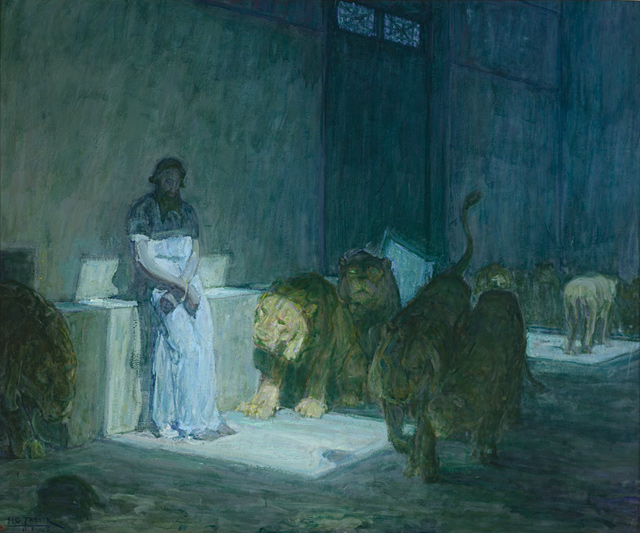The Birth of the California Art Club: Its Founding and First Annual Exhibition

Henry Ossawa Tanner (1859-1937), “Daniel in the Lion’s Den,” 1907-1918; Oil on paper mounted on canvas, 41 1/8″ x 49 7/8″, Los Angeles County Museum of Art, Mr. and Mrs. William Preston Harrison Collection Photograph © 2009 Museum Associate/LACMA
This painting [above] by Henry Ossawa Tanner, now in the collection of LACMA, was not part of the 1929 CAC exhibition at the Hollyhock House, but was purchased directly from the artist when Harrison was in Paris in 1918. Harrison was a well-known Los Angeles collector. [1]
© By Eric J. Merrell, CAC Historian
From the Summer 2009 CAC Newsletter
Obscured by the years and smog of Los Angeles is an historic event: the first black American art exhibition in the city, which was shown in the California Art Club rooms at the Hollyhock House [the CAC’s headquarters from 1927-42, designed by Frank Lloyd Wright], in late 1929. Assembled and premiered in Chicago by William Edouard Scott (1884-1964) and then brought to Olive Hill in Los Angeles with the combined efforts of CAC President Edwin Roscoe Shrader (1878-1960) and Dr. Elzora Gibson of Los Angeles,[2] the exhibition was only possible at the Hollyhock House, as the Los Angeles County Museum of Art (LACMA) would not host a black artist for another six years. In 1935 Beulah Ecton Woodard (1895-1955), founder of the Los Angeles Negro Art Association [in 1937], became the first black American to have a solo exhibition at LACMA. [3]
The December 1929 issue of the California Art Club Bulletin casually mentions that “there will be [Henry Ossawa] Tanner’s work among this representative collection.” [4] The exhibit was described as consisting of “seventy canvases of the leading negro artists of the United States” and also included sculpture, etching and photography, receiving coverage in the local papers. Hanging alongside the highly-decorated Tanner was work by three local artists, Constance Phillips, Paul R. Williams (1894-1980), and A. F. Taynes (Williams and Taynes were also important architects), along with two other artists from Indiana: John Wesley Hardwick (1891-1968), whose exhibited works included Jesus of Nazareth and landscapes, and organizer William Edouard Scott. Scott was an artist of international distinction, whose notable The House Behind the Cedar was exhibited, as well as other paintings. Artist William McKnight Farrow (1885-1967) exhibited “delicately melancholy” landscapes, Hale Aspacio Woodruff (1900-1980) presented landscapes and “scenes of Paris,” and Albert Alexander Smith (1896-1940) showed etchings, while K. D. Ganaway contributed photography to the group. Curtis McHenry and Arthur Taylor both exhibited “naive” works in the form of wood carvings and paintings, including a “curiously carved and decorated box mounted on a carved stick and surmounted by a nude figure” by the former and a painting of “a tiger in the desert” by the latter. [5]
The Sunday reception was opened at 3:00 p.m. with an address given by Francis William Vreeland (1879-1954) of the CAC, followed by Dr. H. Claude Hudson (1886-1989) [6], President of the Los Angeles Branch of the National Association for the Advancement for Colored People (NAACP) and California State Assemblyman Frederick Madison Roberts (1879-1952), the first black man to be elected to that body. A short musical program was presented by Eugene Edgar Page, composer and pianist, and Evelyn Warren, soprano. [7]
Dr. Gibson, a guest at the November 1929 meeting of the California Art Club, spoke and asked “in a plea for the abolition of racial prejudice, told of the all-negro art exhibition to open in the Club rooms on December 1st [1929, running for two weeks]. [8] It comes direct from San Diego, and will be the first of its kind for Los Angeles.” [9] At the same meeting, Richard E. Mann, student and relative of the famous tenor Roland Hayes (1887-1977) [10] sang a number of spirituals and “filled the rooms with…rich and stirring rhythms.” [11] A schedule for the December Forum of monthly CAC events includes a lecture on December 9th by one of the local exhibitors, prominent architect Paul R. Williams, titled “The Negro in Art.” [12]
On the last page of the December 1929 CAC Bulletin is a closing quote from Dr. Gibson: “Color of the skin does not count – only character and the qualities of the human soul is important.” [13]
[1] Author’s email with Ilene Susan Fort, the Gail and John Liebes Curator of Armenian Art, LACMA, 11/25/2008
[2] Exhibitions, December at the Clubhouse, California Art Club Bulletin, Dec. 1929, Vol. IV, No. 12, p.4
[3] Sarah Schrank, Art and the City: Civic Imagination and Cultural Authority in Los Angeles, U. of Pennsylvania Press, 2008, p.178 #110; U. of Missouri, Museum of Art and Archaeology Collections: http://maa.missouri.edu/news/newsrelease-maudelle.html
[4] Exhibitions, December at the Clubhouse, loc. cit. William E. Scott traveled to France in 1909 and 1911 as part of his artistic training; while there, he studied with Henry Ossawa Tanner, one of the leading black American artists of the day (www.AskART.com). This may help explain Tanner’s participation in the exhibition.
[5] Arthur Millier, Negro Art Attracts, Los Angeles Times, December 8, 1929, 21.
[6] Dr. H. Claude Hudson was elected President of the L.A. branch of the NAACP in 1924 and served ten consecutive years. The Dec. 2, 1929 L.A. Times article mistakenly refers to him as “Dr. H. V. Hudson.” http://www.naacp-losangeles.org/history.htm
[7] Exhibitions Opened at Art Center, Los Angeles Times, December 2, 1929, A8; Negro Artists’ Work to be Seen, Los Angeles Times, November 29, 1929, A2.
[8] Exhibitions Opened at Art Center, loc. cit.
[9] November Meeting, California Art Club Bulletin, op. cit., p.2
[10] Roland Hayes was a tenor who was the first African American to win international fame as a concert performer. http://www.georgiaencyclopedia.org/nge/Article.jsp?id=h-1671
[11] November Meeting, loc. cit.
[12] Ibid., p.3
[13] Ibid., p.4


